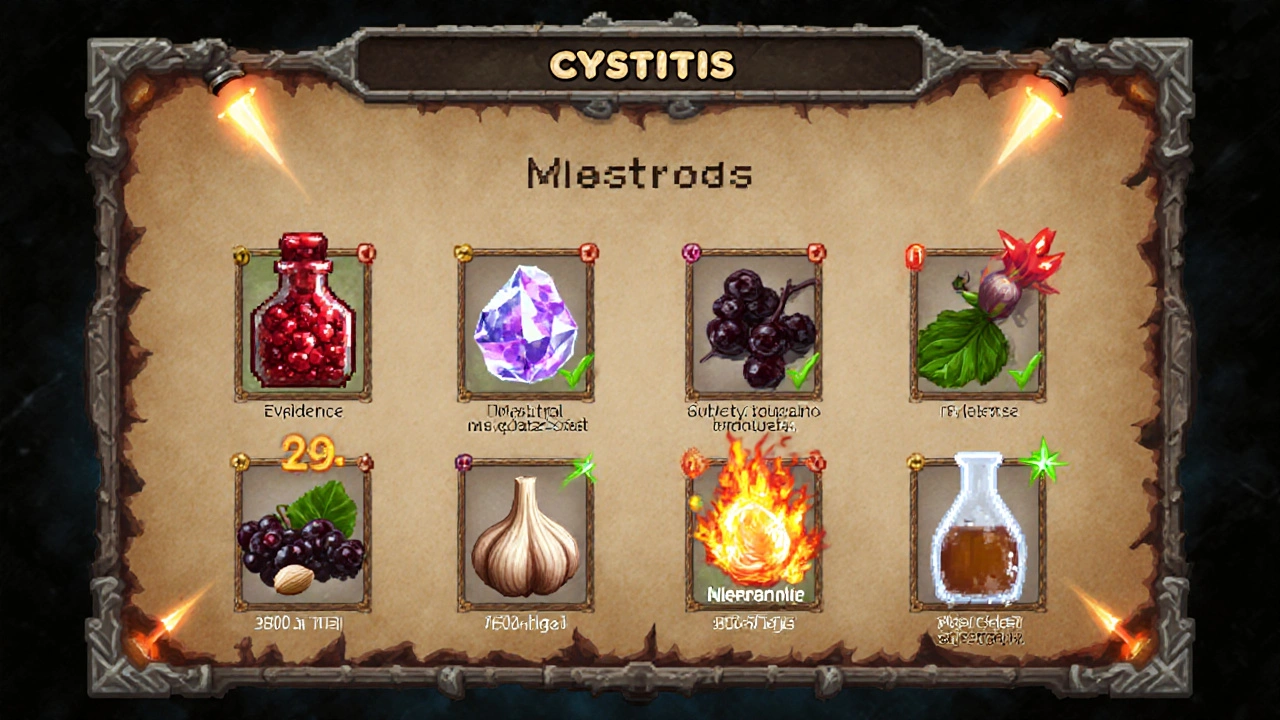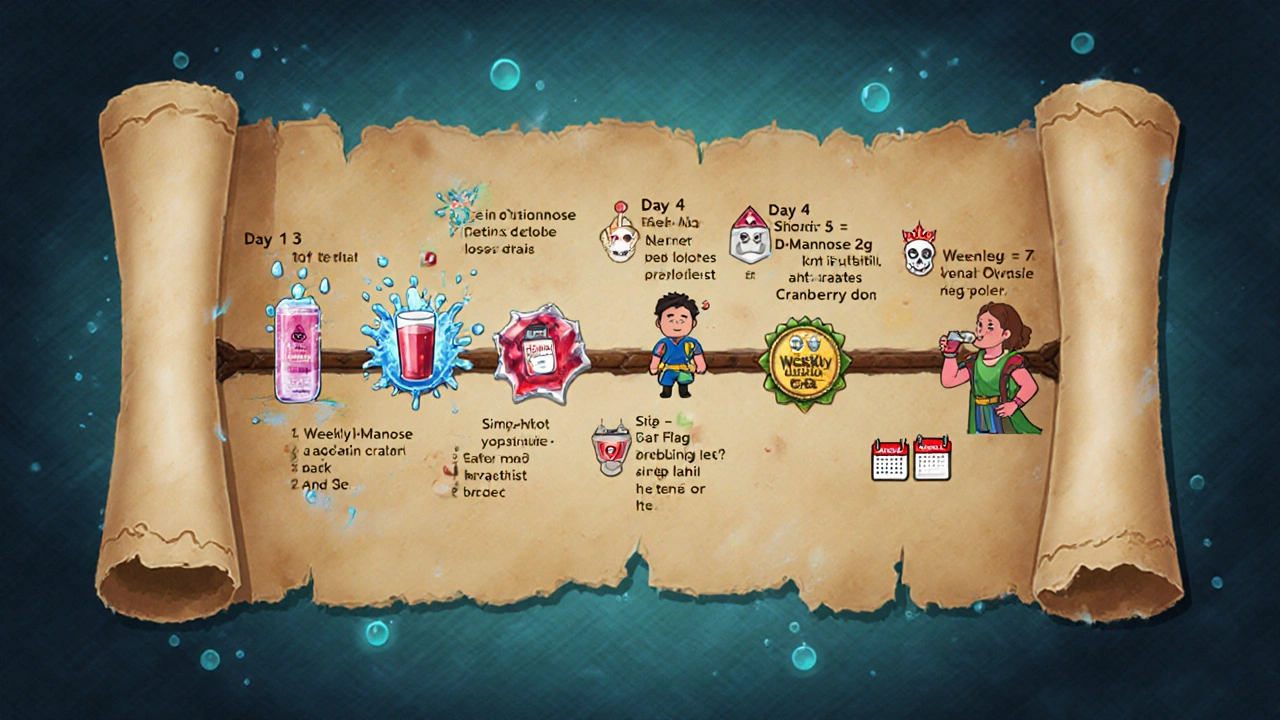Quick Takeaways
- Most mild cystitis cases improve with proper hydration and a few well‑studied herbs.
- Cranberry and D‑Mannose have the strongest research backing.
- Probiotics can help prevent recurrence by balancing gut and vaginal flora.
- UvaUrsi, garlic, and apple cider vinegar may aid symptoms but require careful dosing.
- Seek medical help if fever, flank pain, or blood in urine appear.
Ever wondered if grandma’s kitchen cabinet holds a fix for that burning pee sensation? natural remedies for cystitis have moved from folklore to science‑backed options, but not every herb works the same way. This guide breaks down what actually helps, how to use it safely, and when you still need a doctor.
What Is Cystitis?
Cystitis is a type of urinary tract infection (UTI) that inflames the bladder lining, typically causing urgency, frequency, and a burning sensation during urination. In most adults, the culprit is E. coli - a bacteria that normally lives in the gut but can travel up the urethra. While antibiotics clear the infection quickly, many people look for gentler, repeatable ways to soothe or even prevent future flare‑ups.
Why Consider Natural Remedies?
Antibiotics are life‑saving, but overuse fuels resistance, and side effects like stomach upset are common. Natural agents can:
- Reduce bacterial adhesion to bladder walls.
- Boost urine acidity, making the environment hostile to pathogens.
- Support immune function without harsh chemicals.
That said, “natural” doesn’t equal “risk‑free.” Some herbs interact with blood thinners, others can irritate the stomach. Knowing the evidence level and safe doses is key.

Top Evidence‑Backed Natural Remedies
Cranberry
Cranberry is a tart berry rich in pro‑anthocyanidins, compounds that stop E. coli from sticking to the bladder lining. Studies from 2017‑2023 show daily consumption of 30ml of pure cranberry juice or 500mg of standardized extract cut recurrence risk by roughly 30%.
- Typical dose: 30ml unsweetened juice or 500mg extract, twice daily.
- Side effects: Possible stomach upset; high sugar in sweetened juice may worsen diabetes.
- Best for: Prevention and mild symptom relief.
D‑Mannose
D‑Mannose is a simple sugar that mimics the attachment sites bacteria use on bladder cells, essentially flushing them out with urine. A 2022 double‑blind trial with 200 women found that 2g taken twice daily reduced symptom severity within three days.
- Typical dose: 1-2g dissolved in water, twice a day.
- Side effects: Generally safe; occasional diarrhea at high doses.
- Best for: Acute flare‑ups and early‑stage infections.
Probiotics
Probiotics are live microorganisms, mostly lactobacilli, that colonize the vaginal and gut flora, creating a hostile environment for pathogenic E. coli. A 2021 meta‑analysis covering 12 trials reported a 25% reduction in recurrent cystitis among women taking daily probiotic capsules.
- Typical dose: 10-20billion CFU of Lactobacillus rhamnosus or L. crispatus, daily.
- Side effects: Rare bloating; avoid in severely immunocompromised patients.
- Best for: Long‑term prevention, especially after antibiotics.
UvaUrsi (Bearberry)
UvaUrsi (Arctostaphylos uva‑ursi) contains arbutin, which the body converts to hydroquinone - a mild antiseptic that works inside the urinary tract. Small studies from Scandinavia (2018‑2020) show symptom relief within 4days, but the evidence is less robust than cranberry.
- Typical dose: 300-600mg standardized leaf extract, three times daily.
- Side effects: Can irritate the stomach; not recommended for >2weeks or in pregnancy.
- Best for: Short‑term relief when other options are unavailable.
Garlic (Allicin)
Garlic contains allicin, a compound with broad antibacterial activity, including against E. coli strains resistant to common antibiotics. A 2019 pilot study using aged garlic extract (600mg daily) reported reduced urinary bacterial counts after one week.
- Typical dose: 600mg aged garlic extract, daily.
- Side effects: Bad breath, possible mild GI irritation.
- Best for: Complementary support alongside other remedies.
Apple Cider Vinegar
Apple cider vinegar is acidic (≈5% acetic acid) and can lower urine pH, which may deter bacterial growth. Limited anecdotal evidence suggests it helps with pain relief, but scientific data are sparse.
- Typical dose: 1-2tablespoons diluted in a glass of water, twice daily.
- Side effects: Tooth enamel erosion; avoid undiluted use.
- Best for: Mild symptom alleviation, especially when combined with hydration.
Comparison of the Top Natural Remedies
| Remedy | Evidence Level | Typical Dose | Key Side Effects | Best Use Case |
|---|---|---|---|---|
| Cranberry | Moderate (multiple RCTs) | 30ml juice or 500mg extract, BID | Stomach upset, sugar load | Prevention, mild flare‑ups |
| D‑Mannose | High (large RCTs) | 1-2g in water, BID | Diarrhea at high dose | Acute symptoms |
| Probiotics | Moderate (meta‑analysis) | 10-20B CFU, daily | Bloating (rare) | Long‑term prevention |
| UvaUrsi | Low‑Moderate (small trials) | 300-600mg, TID (≤2weeks) | Stomach irritation, liver strain | Short‑term relief |
| Garlic (allicin) | Low (pilot study) | 600mg extract, daily | Bad breath, GI irritation | Complementary antibacterial |
| Apple Cider Vinegar | Very Low (anecdotal) | 1-2 tbsp diluted, BID | Enamel erosion, heartburn | Mild symptom soothing |
How to Use Natural Remedies Safely
Even natural agents need a plan. Follow these steps before you start:
- Confirm the diagnosis. If you haven’t seen a clinician, a simple dip‑stick test at a pharmacy can rule out complications.
- Hydrate. Aim for 2-3liters of water daily; many remedies work better when the urine is dilute.
- Pick one primary remedy (e.g., D‑Mannose for an acute episode) and add a preventive aid (e.g., probiotics) once symptoms improve.
- Track your response. Note urine color, pain level, and any side effects for at least 5days.
- Know the limits. If you develop fever >38°C, flank pain, or blood in urine, stop the herbal regimen and seek urgent medical attention.

Red Flags: When Home Care Isn’t Enough
Cystitis is usually harmless, but it can mask a kidney infection or a more serious condition. Seek a doctor immediately if you notice:
- High fever or chills.
- Pain radiating to the back or side.
- Persistent vomiting or inability to keep fluids down.
- Blood clots in the urine or sudden, severe pain.
- Repeated infections despite using natural remedies.
These signs often require antibiotics and possibly imaging studies.
Putting It All Together: A Sample 7‑Day Plan
Below is a practical schedule that blends the strongest evidence with safety:
- Day1-3 (Acute phase): D‑Mannose 2g BID + 2L water. Add 30ml unsweetened cranberry juice BID if you tolerate sugar.
- Day4-7 (Recovery): Switch D‑Mannose to 1g once daily, start probiotic 15B CFU each morning, continue cranberry juice.
- Ongoing prevention: Maintain probiotic daily, sip 1tsp apple cider vinegar diluted in water before breakfast, and keep a weekly dose of UvaUrsi during winter when UTIs spike (300mg TID for 5days).
Adjust doses based on personal tolerance and always discuss with a healthcare professional if you’re pregnant, have kidney disease, or take blood‑thinning medication.
Frequently Asked Questions
Can I take D‑Mannose and antibiotics together?
Yes. D‑Mannose doesn’t interfere with most antibiotics and may even help clear bacteria faster. Just follow the dosage instructions on both products.
Is cranberry juice effective if it’s sweetened?
The active pro‑anthocyanidins work regardless of sugar, but added sugar can feed bacteria and worsen blood sugar control. Unsweetened or low‑sugar blends are best.
How long can I safely use UvaUrsi?
Limit to 2weeks at a time. Longer use may stress the liver and cause stomach irritation. Cycle off for at least a week before starting again.
Do probiotics work for men with cystitis?
Research focuses on women, but men also benefit from a balanced urinary microbiome. A daily Lactobacillus supplement can reduce recurrence for both genders.
Is it safe to take garlic supplements while on blood thinners?
High doses of garlic can increase bleeding risk. If you’re on warfarin or similar drugs, stick to culinary amounts or consult your doctor before supplementing.
